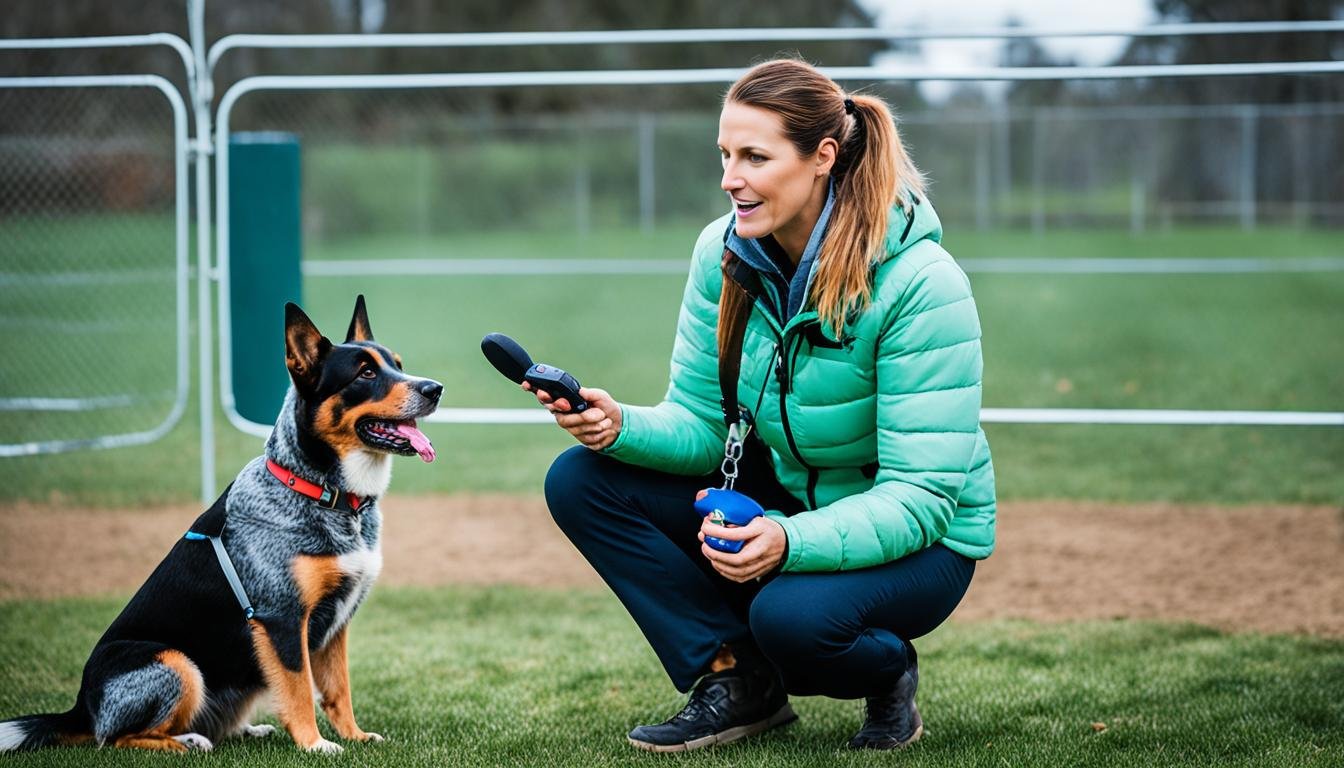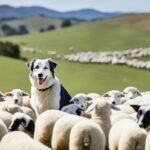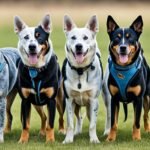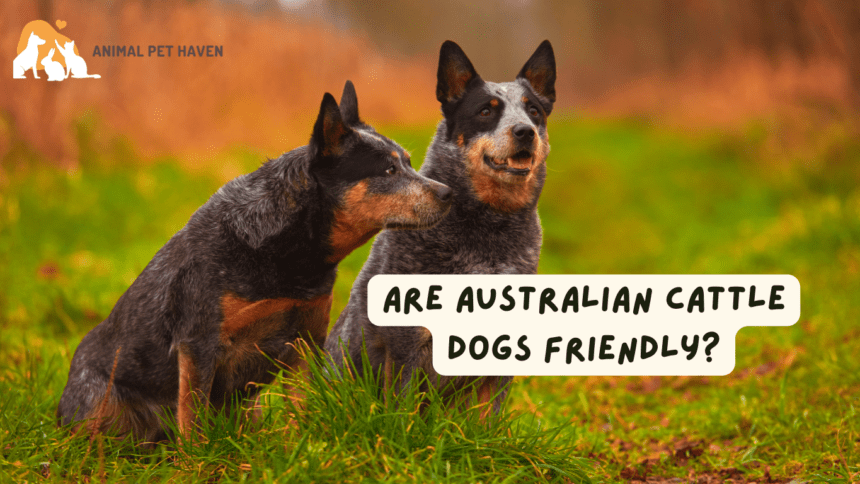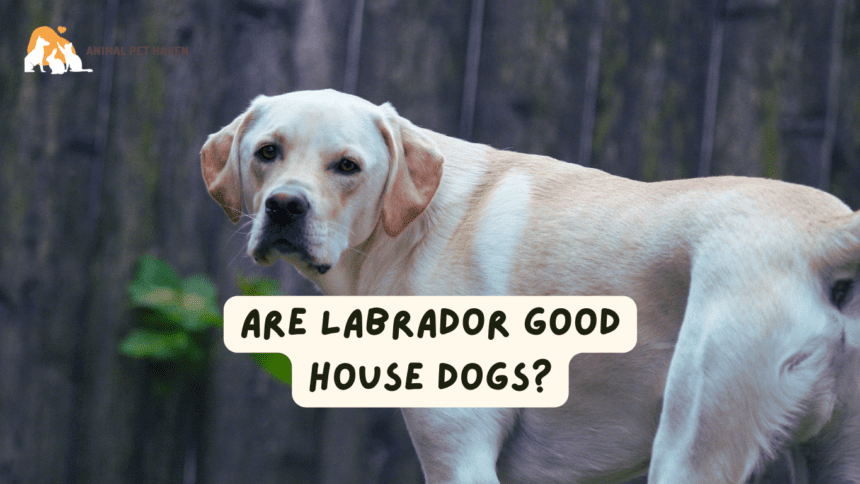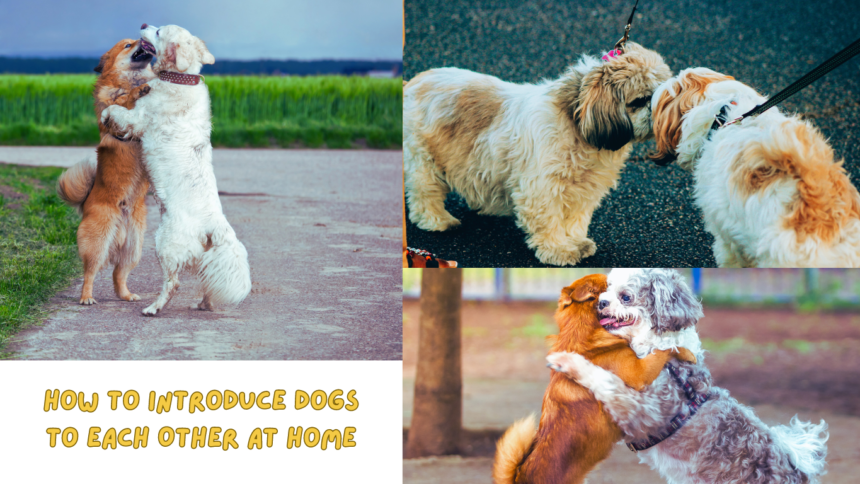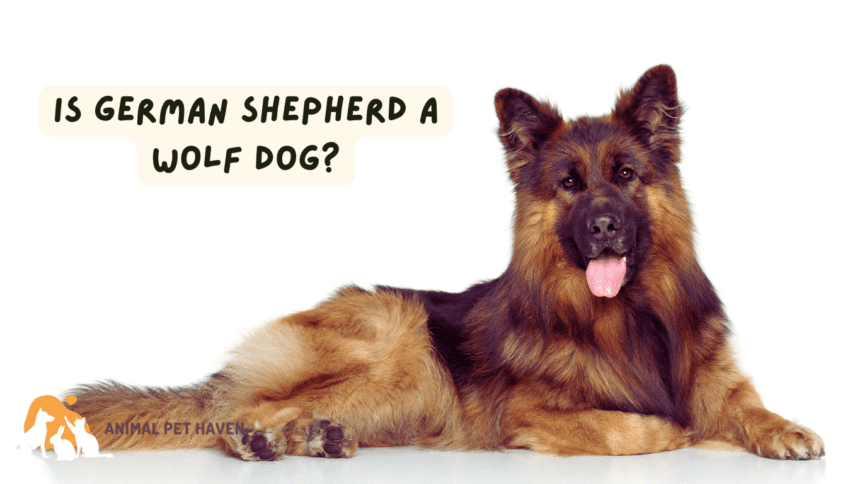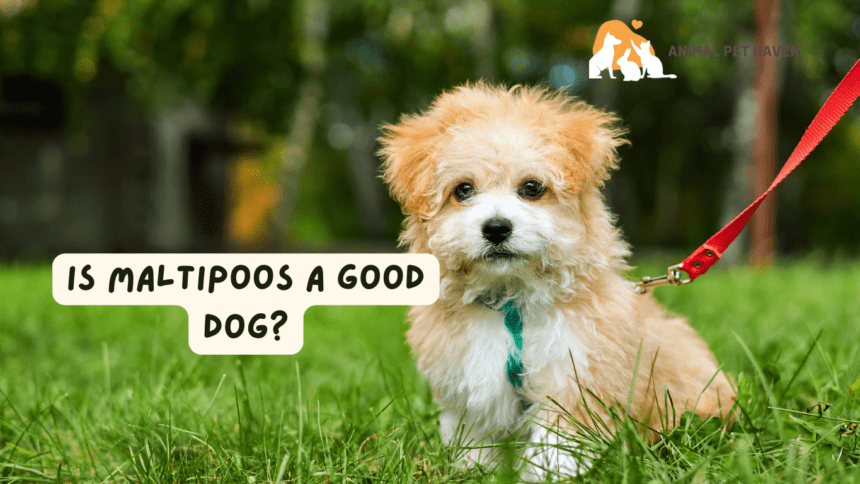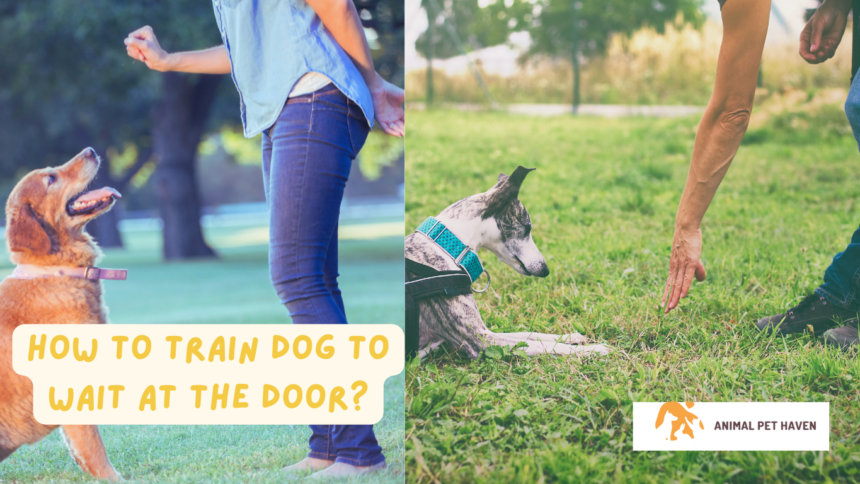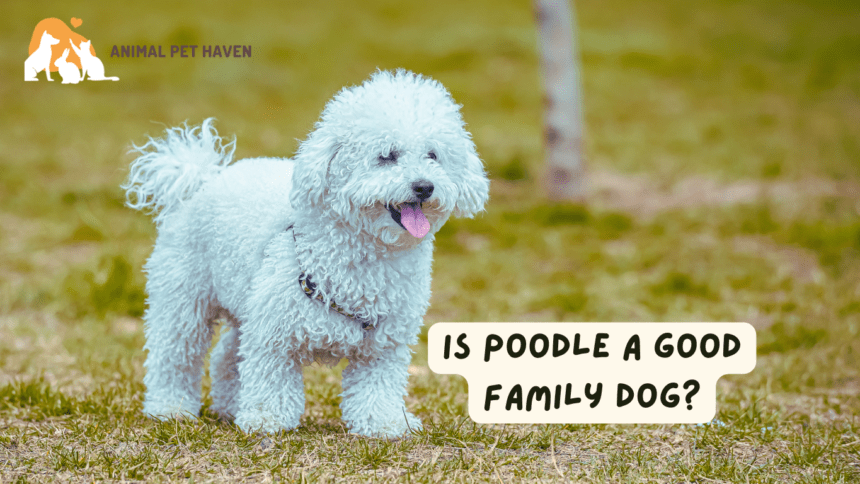The Australian Cattle Dog, known as the Blue Heeler or Red Heeler, is very smart, energetic, and loyal. They love having a job to do and sticking to a routine. It’s vital for dog owners to understand this breed’s unique training needs, especially if you just got a puppy or thinking about adopting an adult one.
To train your Australian Cattle Dog, you need to be patient, consistent, and understand their nature. They excel at working hard, are very agile, and have strong herding instincts, which might lead to nipping or chasing. But, with the right training methods, you can turn your dog into a polite and responsive friend.
In this guide, we’ll go through all you need for training your Australian Cattle Dog. We’ll start from puppy socialization and basic obedience and go all the way to common behavior problems and activities that keep their minds busy. No matter if you’re new to owning a dog or have trained dogs before, this guide will give you the information and skills to train your Australian Cattle Dog well and form a strong bond with them.
Understanding the Australian Cattle Dog Breed
The Australian Cattle Dog is also known as the Blue Heeler or Red Heeler. It’s unique and loved by many. These dogs are intelligent, energetic, and loyal. They come from the tough Australian outback.
History and Origins
In the 19th century, English settlers in Australia needed a dog to help with herding cattle. They crossed various herding breeds, like the Smithfield and Scottish Highland Collie, with the Australian Dingo. This created a tough and smart herding dog, also known as Hall’s Heeler.
Over time, the Hall’s Heeler was further developed into the Australian Cattle Dog. These dogs are still excellent herders. They are also great friends and companions today.
Characteristics and Temperament
Australian Cattle Dogs are full of energy and very smart. They can sometimes be a bit stubborn. They love their family but might be cautious around new people.
Being a herding breed, they like to chase and nip. It’s important to train and socialize them well early on.
They need both mental and physical activities to stay happy. This includes exercise, games like fetch, and long walks. Without enough to do, they might start causing trouble.
| Characteristic | Description |
|---|---|
| Energy Level | High, requires regular exercise and mental stimulation |
| Intelligence | Highly intelligent, quick learners, can be stubborn |
| Loyalty | Loyal and protective of their family |
| Herding Instincts | Strong instincts to chase and nip, requires training and socialization |
| Socialization | Can be wary of strangers, needs early and ongoing socialization |
Even though they can be independent, Australian Cattle Dogs love their owners deeply. They need strong, consistent training and lots of socialization. With the right care, these energetic and smart dogs can be great for active families or individuals.
Preparing for Your New Australian Cattle Dog
Getting an Australian Cattle Dog puppy is a big deal. It’s key to get your home ready and buy everything you need first. This helps your pup and you adjust easily, leading to a happy life together.
Essential Supplies
You’ll need a few things before your Australian Cattle Dog arrives.
- Comfortable crate or bed
- High-quality, age-appropriate dog food
- Food and water bowls
- Collar and leash
- Identification tags
- Chew toys and interactive toys
- Grooming tools (brush, nail clippers, etc.)
- Puppy pads or house training supplies
Pick a sturdy, properly-sized crate for your dog. It should let your pup stretch, move, and sleep easily. When they grow, you’ll need a bigger crate.
Choosing the correct food is vital for your dog’s health. Go for premium puppy kibble that fits its size, age, and breed. Talk to your vet about the best food choices.
Puppy-Proofing Your Home
Australian Cattle Dogs are full of life and very curious. Make sure your space is safe. Here’s how:
- Fix or hide any dangers like cords or poisonous plants.
- Keep the pup away from some spots with gates or closed doors.
- Set up a play area with chew-safe toys.
- Put away chemicals and medicines in a safe spot.
- Check your yard’s fences and hide any dangers outside.
Apart from making your home safe, book regular vet visits. This is especially important for a puppy. They will need shots and care to stay healthy and happy. Your vet will share diet and care tips too.
| Age | Vet Visit Schedule |
|---|---|
| 6-8 weeks | First visit, initial vaccinations, and deworming |
| 10-12 weeks | Second round of vaccinations and deworming |
| 14-16 weeks | Third round of vaccinations and deworming |
| 4-6 months | Rabies vaccination and spay/neuter surgery |
| 1 year and beyond | Annual check-ups, vaccinations, and preventive care |
Prepping your home and getting supplies is a great start. Remember, every dog is different and needs love. Stay calm, be firm, and enjoy your new friend.
Building a Strong Foundation
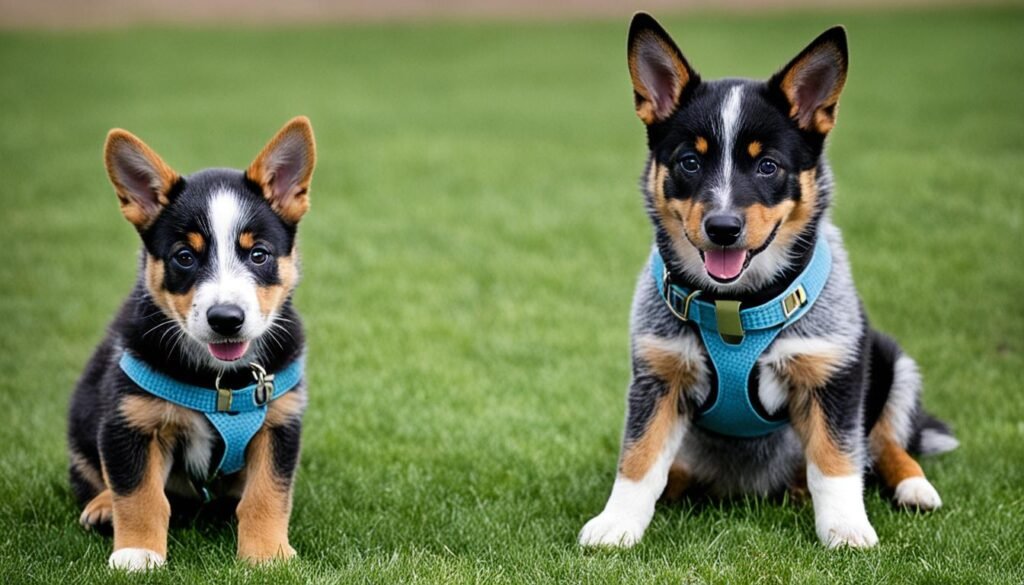
Starting your Australian Cattle Dog‘s training off right is essential. It’s all about getting your pup to trust and respect you. Spend lots of time with your puppy, focusing on fun and positive stuff. Make sure to set clear rules and stick to them. Dogs like ACDs do best with a regular routine.
Have set times for eating, walking, training, and sleeping. This routine helps them know what to expect and learn the rules. Consistency is key. Use positive ways to teach, like praise and treats. This makes training fun and helps you bond with your dog.
Establishing Trust and Respect
Trust and respect are crucial for training your Australian Cattle Dog well. Spend time together doing things that create a bond, like playing and grooming. Praise good actions and steer away from the bad ones gently but firmly. Always be a kind and firm guide. Your dog will look up to you for direction.
Creating a Consistent Routine
Australian Cattle Dogs love a routine. Your ACD will feel safe and happy with a regular schedule. Consider using a crate for sleeping or quiet time. It provides a den-like place they’ll enjoy. Regular and fun training sessions help a lot, too. They keep your dog sharp and reinforce good behavior.
| Training Tip | Benefit |
|---|---|
| Use positive reinforcement | Encourages good behavior and strengthens bond |
| Be consistent with rules and boundaries | Helps your dog understand expectations |
| Create a predictable routine | Provides structure and security for your pup |
| Engage in regular, short training sessions | Maintains focus and reinforces good behavior |
Every Australian Cattle Dog is different. So, you might need to change training methods to fit your dog. No matter what, stay patient and use positive teaching. This is how you lay a solid foundation for your dog’s training. Good luck!🐶
Basic Obedience Training
The key to a well-behaved Australian Cattle Dog is learning the basics. You start with commands like sit, stay, and come. This creates a strong foundation for more advanced training. Remember, being steady and gentle is crucial for teaching these commands to your puppy or adult dog.
Teaching Essential Commands
Begin with easy orders like sit, stay, and come. Use short, clear phrases along with hand signs. This helps your dog get what you mean. Keep sessions brief, interesting, and joyful to keep your dog focused.
As your dog gets better, you can make things more challenging. For example, you can ask your dog to hold the command for a longer time or from further away. Always keep it fun and progressively harder to keep your dog engaged.
For the heel command, start in a place without distractions. Put your dog on a leash and walk, encouraging them to stay by your side. If they slip up, make them sit before walking again. Always give them a treat and praise for doing it right.
Positive Reinforcement Techniques
Positive reinforcement works great for Australian Cattle Dogs. This means rewarding your dog with treats, cheers, or a toy when they do well. It helps them understand what you want and enjoy learning.
When using positive reinforcement, the timing of giving rewards is extremely important. Always reward right after the good behavior. This helps your dog make the connection between the action and the reward. Plus, everyone in the family should use the same commands and rewards.
| Command | Hand Signal | Verbal Cue |
|---|---|---|
| Sit | Hand palm facing up, moving upward | “Sit” |
| Stay | Hand palm facing forward, held up | “Stay” |
| Come | Hand moving towards chest | “Come” or dog’s name |
| Heel | Hand at side, patting leg | “Heel” |
Remember that obedience training is just the start. Don’t overlook vital areas like potty training, crate training, and making friends. These are all vital for your dog’s overall growth. They help your dog become not just well-trained but also happy and well-behaved.
Socialization and Exposure
Socializing your Australian Cattle Dog puppy is vital. The best time for this is between 3 and 14 weeks, with the key period being 3-5 weeks. It’s crucial to show your puppy many new people, animals, places, and things in a positive light. This builds the foundation for a well-rounded adult dog.
Use treats, toys, and kind words when introducing your puppy to new things. Make sure they’re comfortable with being touched on their ears, paws, and mouth. This makes check-ups and grooming easier in the future. Have clear rules and be patient, so your pup doesn’t get too overwhelmed, avoiding stress and fear.
Starting socialization after 14 weeks old might not work well. Forcing a fearful puppy into situations can make them afraid or aggressive. Always reward good actions to help your puppy connect good things with new experiences.
| Do’s of Australian Cattle Dog Puppy Socialization | Don’ts of Australian Cattle Dog Puppy Socialization |
|---|---|
| Expose your puppy to various people, animals, and environments | Overwhelm your puppy with too many new experiences at once |
| Use treats, toys, and praise to create positive associations | Physically push your puppy into uncomfortable situations |
| Regularly touch your puppy’s ears, paws, and mouth | Neglect to reward good behavior during socialization |
| Maintain consistent rules and boundaries | Use harsh disciplinary techniques like yelling or physical punishment |
| Enroll your puppy in a professional obedience program | Allow your puppy to play with other dogs unsupervised |
When socializing, avoid crowded and loud areas. Be cautious of letting your puppy roam freely on a retractable leash. Take your puppy out when they’re alert, not when they’re tired. Always keep an eye on your dog in public places to prevent accidents.
Australian Cattle Dogs need a lot of sleep, up to 20 hours in their puppy stage. Make sure they have quiet playtime to rest and balance their energy. Stick to a schedule; it helps them understand what to expect and when. By being consistent, you show them the right way to act.
A well-socialized Australian Cattle Dog becomes confident and friendly. By training and socializing your puppy properly, you’re giving them a great start in life. Follow these tips for training your puppy, and they’ll grow into a happy, well-rounded adult dog.
Addressing Herding Instincts
Australian Cattle Dogs, or heelers, love to herd livestock. This herding instinct runs deep in them. Living at home, they might nip at heels or chase after things.
These behaviors aren’t always bad, but they can cause issues. It’s important to train and help them find other things to do.
Redirecting Nipping and Chasing
If your Cattle Dog puppy starts nipping or chasing, redirect them right away. Use a toy or play a game with them. This helps turn their energy into something positive.
Consistency is very important. Always use the same method to stop the unwanted behavior. With time and effort, your dog will understand what’s not okay.
Providing Appropriate Outlets
Besides redirection, offer them outlets for their herding instinct. This can be through specific activities, such as:
- Herding balls or toys made for herding dogs
- Intelligent puzzle toys
- Agility courses for their speed and agility
- Treibball, a fun sport about herding balls
These activities allow your dog to use their instincts positively. It prevents bad behaviors and keeps them happy and well-behaved.
| Herding Dog Breed | Key Characteristics |
|---|---|
| Border Collie | High energy, intelligent, agile |
| Australian Cattle Dog | Tough, loyal, protective |
| Belgian Malinois | Intense, dedicated, often used in police and military work |
| Shetland Sheepdog | Agile, intelligent, strong work ethic |
| German Shepherd | Versatile, excels in various roles from herding to service work |
Training an Australian Cattle Dog needs patience and being consistent. With positive training and understanding their instincts, they will be a great part of your family.
Advanced Training Techniques
Your Australian Cattle Dog can learn lots once basic obedience is clear. Time for more advanced training. These methods give your clever heeler a workout and make your bond stronger. About 80% of Australian Cattle Dog owners try things like agility and scent tracking to keep their pups sharp.
Agility and Obstacle Courses
Agility courses are top-notch for Australian Cattle Dogs. They blend mental and physical challenges. Your dog will go through tunnels, jump over bars, and weave through poles. This routine boosts their fitness and sharpens their focus, obedience, and problem-solving.
Start agility slowly, with each obstacle properly taught. Praise the small steps. This motivates 70% of ACD owners’ dogs to learn faster. As your dog gets better, up the challenge and speed of the course.
Scent Work and Tracking
Scent work is great for these smart sniffers. It makes them find specific smells, like essential oils or human scents. This kind of training really uses their skills and instincts.
Begin by showing them the target scent and rewarding their interest. Then, make the scent hunt tougher. With tracking, your dog will learn to stay on a scent trail. This helps with search missions or just for fun.
| Training Method | Benefits | Percentage of ACD Owners |
|---|---|---|
| Agility Training | Improves focus, obedience, and problem-solving skills | 80% |
| Scent Work | Mentally stimulating and taps into natural instincts | 80% |
| Tracking | Teaches dog to follow a specific scent trail | 80% |
Agility and scent work not only make dogs cleverer but also curb bad habits. 75% of Australian Cattle Dogs act out when bored. Doing these advanced activities keeps their minds busy and prevents issues.
Exercise and Mental Stimulation
The Australian Cattle Dog is a smart, high-energy breed. It needs an active life to stay both physically and mentally healthy. Owners must make sure their dogs get enough exercise and play to keep them happy and avoid bad behavior. Each cattle dog might need a little different kind of activity, but they all love challenges for their bodies and brains.
Daily Physical Activities
These dogs enjoy many kinds of activities due to their natural fitness and energy. Playing fetch, doing agility, going on long walks, and hiking are all great for them. Your canine friend should have about an hour of exercise every day. A dog that’s had good exercise will be better behaved!
| Activity | Duration | Benefits |
|---|---|---|
| Fetch | 20-30 minutes | Improves cardiovascular health and coordination |
| Agility Training | 30-45 minutes | Enhances agility, obedience, and problem-solving skills |
| Long Walks | 45-60 minutes | Provides mental stimulation and bonding time |
| Hiking | 1-2 hours | Offers physical challenge and exposure to new environments |
Interactive Toys and Puzzles
Cattle dogs also need to exercise their minds. Interactive toys and puzzles are perfect for this. They are fun activities that keep dogs alert. Some good choices are:
- Puzzle feeders that make dogs think to get their food
- Treat-dispensing toys that challenge your dog to solve them
- Hide-and-seek games that mimic their hunting skills
By mixing up physical exercise with mental challenges, your dog will lead a truly rewarding life. A happy, well-exercised, and mentally sharp dog is less likely to cause trouble. Instead, they’ll be a happy and faithful friend to you.
Dealing with Common Behavioral Issues
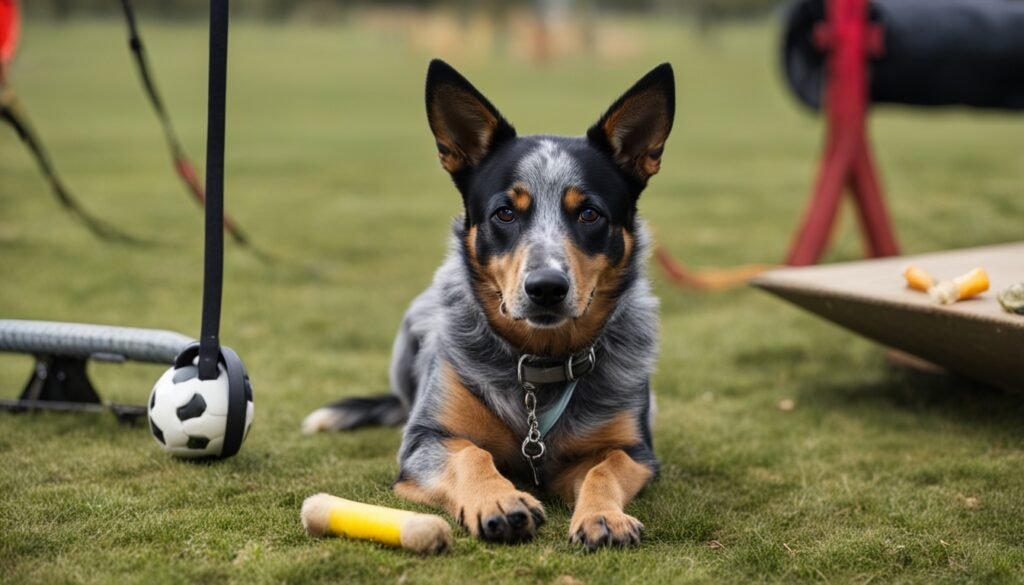
Even with the best training, Australian Cattle Dogs sometimes show behavioral problems. These may include too much barking, chewing things up, and being too attached to their owners. As a pet owner, you need to work hard and fast to solve these issues. This stops them from becoming regular habits.
If your ACD barks a lot, it could be from anxiety or boredom. Teaching them to be quiet and using toys that challenge them can help. ACDs might chew things or try to get away if they’re not getting enough exercise or mental activity. Make sure they have things to chew on, protect your stuff with safe sprays, and keep them active every day.
When ACDs get too worried about being alone, they might start destroying things. To stop this, experts suggest getting your dog used to being alone bit by bit. Also, keep your dog’s mind busy with toys or treats hidden around the place. Being clear and consistent with rules is key in making sure your dog knows you’re in charge.
Other issues ACDs may have are:
- Acting aggressively to strangers or other dogs to protect their space, which means they should meet many types of people and dogs early on.
- Trying to nip or lead people because of their natural herding instinct, which needs lots of exercise and activities to use it properly.
- Getting too bossy if they don’t know their place, so it’s important to show them you lead them and reward good behavior.
- Running after moving things, this can be dangerous and needs you to train and watch them closely.
To deal with these challenges, you usually need to work on a few things at once, as you can see in the table below:
| Behavioral Issue | Potential Solutions |
|---|---|
| Excessive Barking | Teach “quiet” command, provide mental stimulation, address underlying anxiety |
| Destructive Chewing | Provide appropriate chew toys, use deterrents, ensure adequate exercise |
| Separation Anxiety | Gradual solitude introduction, provide mental stimulation, consult professional trainer |
| Aggression | Socialization, positive reinforcement training, establish clear boundaries |
| Herding Instinct (Nipping/Biting) | Redirect to appropriate activities, provide adequate exercise and mental stimulation |
| Dominance Issues | Establish clear leadership, set boundaries, encourage positive behavior |
| Chasing Behaviors | Training, supervision, provide alternative outlets for instinctive behaviors |
Be sure not to use punishment. Instead, focus on rewarding good behavior. Be patient and gentle with your pet. If the problems go on, or if you find them too hard, get help from a professional trainer who is familiar with Australian Cattle Dogs.
Nutrition and Health Care
Keeping your Australian Cattle Dog healthy and happy for life is all about proper nutrition and ongoing health checks. It’s your duty as a dog owner to pick the right food. This food should match their age, size, and how much they move.
While Australian Cattle Dogs are hearty, they can still face health problems. Visit the vet often to catch any issues early. They might have problems like hip dysplasia and deafness. So, regular check-ups are a must.
- Hip dysplasia
- Elbow dysplasia
- Luxating patella
- Deafness
- Progressive retinal atrophy
- Bladder stones
- Dermatomyositis
Australian Cattle Dogs can live 12-14 years on average. Bluey, a Cattle Dog, holds the record for the oldest dog ever at 29 and a half years. This breed is tough and can live a long life.
Choosing the Right Dog Food
When picking food for your Cattle Dog, choose one made for their age and size. They are medium-sized dogs with lots of energy. A good diet helps them stay active and healthy.
Look for food with chicken, beef, or fish as the main part. Stay away from foods with a lot of fillers or artificial stuff. Your vet can help you figure out the right food for your dog’s needs.
Regular Vet Check-Ups
Regular visits to the vet are important for your Cattle Dog. These wellness checks should happen once or twice a year. Your vet will check your dog’s health and update their vaccines.
Keeping pests away is also crucial. Your vet can suggest the best way to protect your dog from fleas, ticks, and worms. This protection depends on your dog’s lifestyle and where you live.
| Preventive Care | Frequency |
|---|---|
| Wellness exams | Every 6-12 months |
| Vaccinations | As recommended by your vet |
| Parasite control | Monthly or as directed |
| Dental care | Regular brushing and professional cleanings as needed |
With good food, check-ups, and care, your Cattle Dog can have a long and happy life. On BorrowMyDoggy, there are 143 Australian Cattle Dogs, with names like Dexter. It shows how this smart and active breed is loved by many.
How to Train an Australian Cattle Dog: Tips from Experts
Training an Australian Cattle Dog is a challenge, but it’s easier with expert advice. Experienced breeders and trainers share wisdom about this breed’s unique traits. They suggest starting early, being consistent, and using positive methods. They also say to adjust your training to your dog’s personality.
Insights from Experienced Breeders and Trainers
Experts stress the need for your ACD to meet many people and animals early on. This helps them grow into well-rounded and confident dogs. Going to group classes is a great way to help your dog socialize and learn. They also advise on keeping lessons short and to the point, multiple times per day.
Positive reinforcement plays a big part in training your ACD well. While treats are great, they shouldn’t be the only reward. A mix of treats, praise, and play works best. Remember, training a dog takes time, and you must be adaptable. Every ACD is different, so what works for one may not work for another.
FAQ
At what age should I start training my Australian Cattle Dog?
Begin training your Australian Cattle Dog early, ideally when they’re a puppy. This helps them become a well-behaved adult dog. Start teaching them basic commands and show them new things from about 8 weeks old.
How much exercise does an Australian Cattle Dog need?
These dogs are very energetic and need lots of exercise. Make sure they get at least an hour of activity every day. This can be from long walks, playtime, or running. Also, include toys and puzzles for their mind.
Are Australian Cattle Dogs easy to train?
Australian Cattle Dogs are smart and like to make you happy, making training simpler. But, they can also be stubborn. It takes time and staying consistent with training. Using rewards like treats and kind words works best.
How do I stop my Australian Cattle Dog from nipping at heels?
Their behavior comes from their herding nature. To stop the nipping, redirect their focus to a toy or game. Satisfy their herding urge with activities like chasing a ball or going through an agility course.
Are Australian Cattle Dogs good with children and other pets?
Yes, they can be, if trained and socialized properly. But, their herding instincts might lead them to try and govern over small animals. Always watch how they interact and teach everyone to behave nicely around each other.
How often should I feed my Australian Cattle Dog?
Feeding amounts depend on the dog’s age and health. Puppies need to eat more often, about 3-4 times a day. Adult dogs can eat twice daily. Remember to always have fresh water available. Talk to the vet for a custom feeding plan for your dog.
How can I prevent separation anxiety in my Australian Cattle Dog?
For separation anxiety, get your dog used to being alone slowly. Begin with short times apart. Create a cozy space with toys for entertainment. Try not to make a big deal when leaving or coming back.
Can Australian Cattle Dogs be trained for agility and other dog sports?
Absolutely, they do very well in sports like agility and frisbee. These activities keep them both physically and mentally fit. Plus, it’s a great way to grow your bond with your dog.

